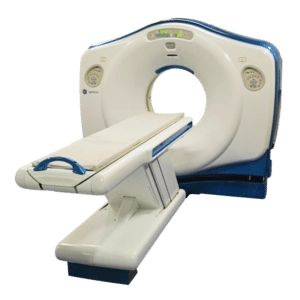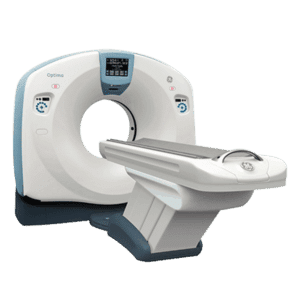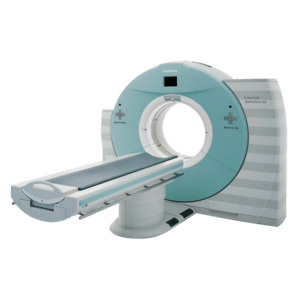CT Scanner Maintenance: Calibration
What is a CT Simulator?
The terms CT scanner and CT sim are sometimes used interchangeably which can cause confusion. A CT sim is both a procedure and a machine. This article will explain the differences between the two machines and what is a CT simulation procedure.
Let’s start with the CT simulation procedure, it is the process done before a radiotherapy treatment to determine the exact size, location and shape of a tumor. With the images taken the Oncologist and radiotherapy team can plan a custom-made treatment for the oncology patient. The CT simulator is a Computed Tomography scanner equipped to take Images of the tumor to help that process.
The CT Simulator is specifically designed for CT sim procedures with a large bore (80 cm or more), a flat table top like the one used in the Linear Accelerator (LINAC), laser positioning devices that aid in marking the patient for radiation therapy and virtual simulation imaging software.
The CT simulation procedure has three phases
- The creation of an immobilization device: During the radiation treatment it’s imperative that the patient remain still during the procedure, for this reason an immobilization device is necessary to ensure the tumor can be targeted to millimeters to preserve healthy tissue. Immobilization devices are custom-made to fit over areas of the body such as the head, neck or pelvic regions.
- CT scans: With the oncology patient in position, images are taken of the tumor. The CT sim procedure mimics the patient’s position in the linear accelerator in all aspects, except the delivery of the therapeutic beam.
- Targeting marks: Marks will be placed on the patient’s body for localization of the radiation beam. The marks are not permanent but will need to stay on the patient until the last day of radiation therapy.
There are many CT simulator brands and models to choose from, but some of the more recognized ones include the Siemens Sensation, part of the Siemens Somatom portfolio. The Philips Brilliance Big Bore and the Discovery RT from General Electric.
Here’s a breakdown of these familiar CT sim models.
- GE Discovery RT
GE’s Discovery RT CT scanner uses proprietary algorithms to leverage collected data that traditional algorithms ignore. Powered by a 100KW generator and 0.625 mm slices delivers superior 2D and 3D images.
- Siemens Sensation:
This Siemens Somatom combines an 82cm gantry aperture to accommodate different size patients, with advanced multi-slice CT technology. It acquires high-definition images up to 40 slices per rotation. It also includes respiratory gated features that aid in treatment planning and offers many software options in addition to other Somatom Scanners.
- Philips Brilliance:
The Philips Brilliance iPatient technology provides patient-centered imaging for simulation and treatment planning. The user-friendly interface manages image quality, dose, and speed of acquisition for oncology and diagnostic procedures.
Get Started
Request Pricing Today!
We’re here to help! Simply fill out the form to tell us a bit about your project. We’ll contact you to set up a conversation so we can discuss how we can best meet your needs. Thank you for considering us!
Great support & services
Save time and energy
Peace of mind
Risk reduction
Which CT machine to purchase: A standard CT scanner or a CT sim?
If you are considering the purchase of a CT scanner or a CT simulator and want to know about pricing, please look at our guide on CT Machines cost. Remember that a CT simulator is a CT scan machine equipped to take images to help in the planning of radiation therapy sessions for oncology patients. Places that treat a large population of oncology patients will be better off with a CT Sim Scanner. For other institutions where the patient population varies, a regular CT scanner can be adequate.
Consult with your imaging team and see what CT unit fits your imaging needs.
References
https://www.radiation-therapy-review.com/CT_Simulator.html
https://www.sciencedirect.com/topics/nursing-and-health-professions/computed-tomography-simulator



